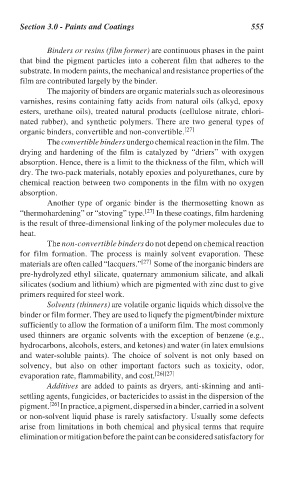Page 585 - Handbook of Thermal Analysis of Construction Materials
P. 585
Section 3.0 - Paints and Coatings 555
Binders or resins (film former) are continuous phases in the paint
that bind the pigment particles into a coherent film that adheres to the
substrate. In modern paints, the mechanical and resistance properties of the
film are contributed largely by the binder.
The majority of binders are organic materials such as oleoresinous
varnishes, resins containing fatty acids from natural oils (alkyd, epoxy
esters, urethane oils), treated natural products (cellulose nitrate, chlori-
nated rubber), and synthetic polymers. There are two general types of
organic binders, convertible and non-convertible. [27]
The convertible binders undergo chemical reaction in the film. The
drying and hardening of the film is catalyzed by “driers” with oxygen
absorption. Hence, there is a limit to the thickness of the film, which will
dry. The two-pack materials, notably epoxies and polyurethanes, cure by
chemical reaction between two components in the film with no oxygen
absorption.
Another type of organic binder is the thermosetting known as
“thermohardening” or “stoving” type. [27] In these coatings, film hardening
is the result of three-dimensional linking of the polymer molecules due to
heat.
The non-convertible binders do not depend on chemical reaction
for film formation. The process is mainly solvent evaporation. These
materials are often called “lacquers.” [27] Some of the inorganic binders are
pre-hydrolyzed ethyl silicate, quaternary ammonium silicate, and alkali
silicates (sodium and lithium) which are pigmented with zinc dust to give
primers required for steel work.
Solvents (thinners) are volatile organic liquids which dissolve the
binder or film former. They are used to liquefy the pigment/binder mixture
sufficiently to allow the formation of a uniform film. The most commonly
used thinners are organic solvents with the exception of benzene (e.g.,
hydrocarbons, alcohols, esters, and ketones) and water (in latex emulsions
and water-soluble paints). The choice of solvent is not only based on
solvency, but also on other important factors such as toxicity, odor,
evaporation rate, flammability, and cost. [26][27]
Additives are added to paints as dryers, anti-skinning and anti-
settling agents, fungicides, or bactericides to assist in the dispersion of the
pigment. [26] In practice, a pigment, dispersed in a binder, carried in a solvent
or non-solvent liquid phase is rarely satisfactory. Usually some defects
arise from limitations in both chemical and physical terms that require
elimination or mitigation before the paint can be considered satisfactory for

